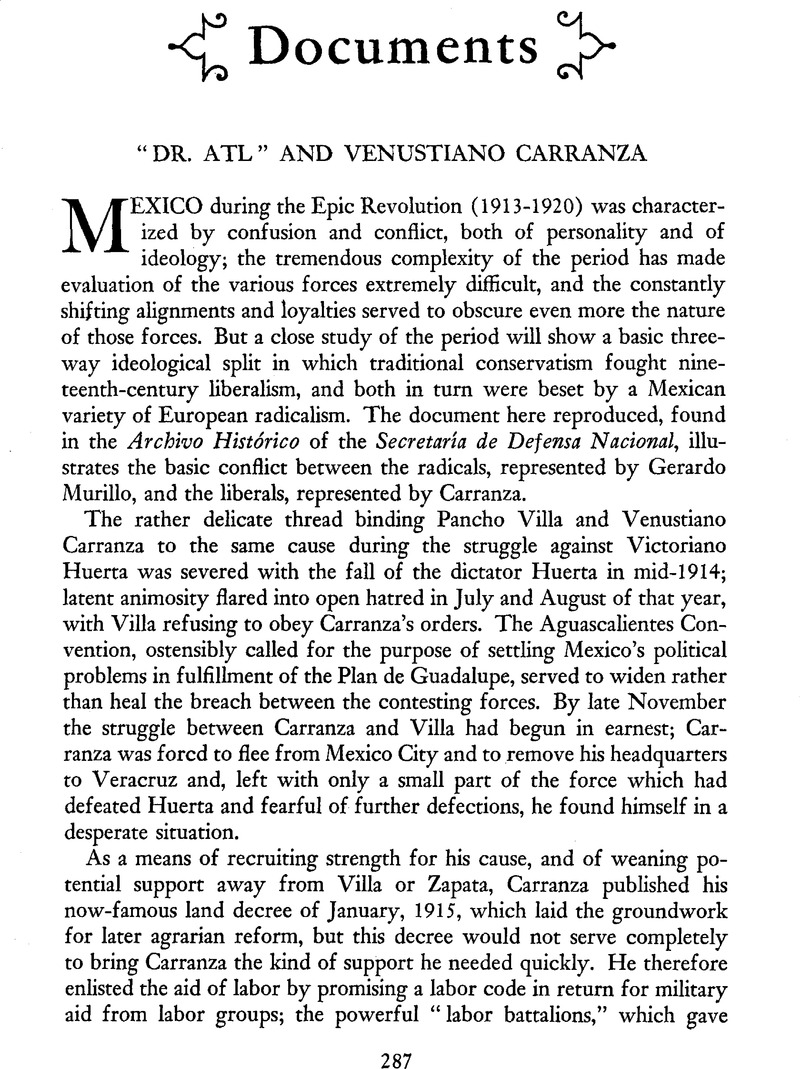Published online by Cambridge University Press: 11 December 2015

1 The reference here is to a cabinet crisis in which a number of posts were reshuffled; both Félix F. Palavicini and Luis Cabrera were involved in the quarrel, and the result meant a loss of influence by that wing represented by Atl.
2 The lighthouse in Veracruz, which Carranza used as the seat of government during most of 1915.
3 José Natividad Macias, who had served in the governments of Manuel González and Porfirio Díaz in various capacities. He was in attendance upon Carranza’s government all during this period, and is generally credited with having drafted the constitutional plan submitted to the Querétaro Congress.
4 Luis Cabrera, who had served in Congress both under Diaz and under Madero, and who occupied various posts under Carranza; he was best known as Carranza’s Minister of Finance and was bitterly criticized for his failure to stabilize the peso and for alleged graft.
5 Murillo’s contemptuous labelling of the “renovadores” as reactionaries is probably the best demonstration of the split which had occurred. In actuality, the “renovadores” were those of the Madero Congress who banded together after Huerta’s coup and defied, in Congress, the activities of the dictator; most of them, as a consequence, were put in considerable personal danger and had served some time in prison.
6 Antonio Manero and his brother were hangers-on, generally engaged in journalistic endeavors of a propagandistic nature; they were reputedly engaged in almost unbelievable graft.
7 Félix F. Palavicini was with both the Madero and Carranza governments in various capacities; he was Carranza’s first Minister of Education as well as his director of publicity and manager of the government-subsidized press. At that date he was editor of El Universal and a newly-elected member of Congress.
8 Manuel Ugarte, Luis Manuel Rojas, Rafael Nieto, Antonio Manero, Marcelino Dávalos, and Félix F. Palavicini.
9 Gonzalo de la Parra, one of the “renovadores” and a Palavicini aide in the publicity department at Veracruz.
10 In late March, Gonzalo de la Parra, the editor of El Sol, published an article entitled “El privilegio de las Aguilas” in which he accused the army of refusal to obey orders or to abide by law, and which he closed by charging that the army was responsible for ninety percent of the crimes in Mexico. Palavicini, who had recently founded El Universal and who was then editor of that daily, republished the article on the following day. That night General Benjamin Hill, one of the old Sonora revolutionaries, accused Luis Cabrera of writing the article, roundly upbraiding Cabrera for the insult to the military forces. A moment later, according to rumors rampant at the time (but which Palavicini does not mention) Hill engaged in a heated discussion with Palavicini, finally striking the editor in the face. On March 29, de la Parra and Palavicini were both arrested by the army, and at the time Murillo wrote this letter Palavicini was being held at the military headquarters. Two days later, Palavicini was accused of treason under a law of 1862. During the entire affair it was perfectly clear that Carranza’s sympathies were with Palavicini; he had little use for the army point of view, and his attitude may well have been the stimulus for de la Parra’s article. In spite of his sympathies, however, Carranza apparently felt that he could do nothing overt in Palavicini’s behalf; the editor finally resolved the quandary by escaping from the military and going into hiding.
11 It will be noted that nowhere in the letter does Atl emphasize the need for democratic practices. He comments on, but does not criticize, Carranza’s dictatorial power; furthermore, the entire burden of the letter is that Carranza should take a course of action in the social and economic field without regard to political democracy. Implicit in the letter is that Mexico is not a democracy, that there should not be freedom of speech or press, but that the president should exercise dictatorial power–but that the exercise of these powers should be in behalf of the Revolution as Atl defined it. To Atl the “spirit of the Revolution” was rapid social and economic change without regard to existing (or ideal) constitutional or legal limitations. Carranza, on the other hand, was committed to the form at least of political democracy and was only mildly interested in evolutionary social change.